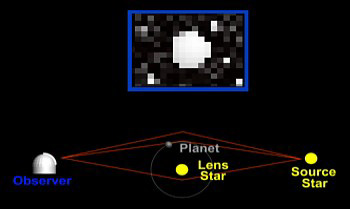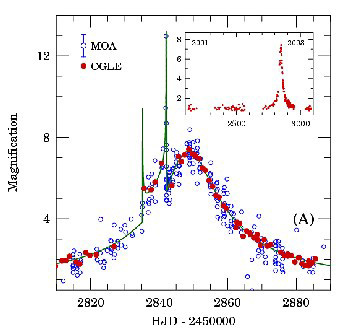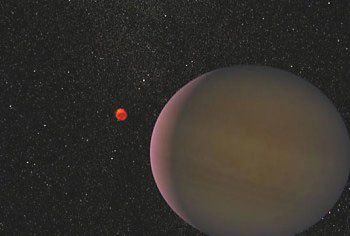In a galaxy not so far away … the presence of a planet orbiting a distant star in the Milky Way galaxy was observed during a week-long window of opportunity during observations by a team of 32 researchers. The existence of the planet was deduced, not by the standard method of observing a slight change in the star’s spectrum when tugged by the planet, but rather by the way in which the planet and the star about which it orbits some 17,000 light years away towards the central part of the galactic disc, in the constellation of Sagittarius, distorted the image of a more distant, background, star, some 24,000 light years away.
Several detector groups are set up to monitor the passage of stars in the Milky Way passing behind or near foreground objects with the aim of spotting dark matter, brown dwarves and other stars. The detectors hope to make sense of the changes in the way the light curves for the background objects. Ian Bond of the Institute for Astronomy in Edinburgh and his colleagues at two detector groups, the Microlensing Observations in Astrophysics (MOA) and Optical Gravitational Lensing Experiment (OGLE) have now reported their analysis of a week’s observations last summer that show that for one distant star the characteristic brightening light curve, just before a gravitational lensing event, had several unexpected extra spikes. The team interpreted these spikes as being due to two neighbouring massive objects.

Schematic diagram showing how microlensing helps astronomers find new planets (Credit: NASA)
Further analysis showed that one of the pair was less than half a percent as massive as the other. This suggests a star-planet pairing with the putative planet having a mass 1.5 times that of the biggest planet in the Solar system, Jupiter. The discovery represents the most distant giant planet to be detected orbiting an ordinary star in the Milky Way and the first planet outside the Solar system found using the gravitational microlensing technique. Astronomers are pinning their hopes on this technique revealing the presence of much smaller planets, about the size of the Earth, around other stars.
Gravitational microlensing was first proposed by Bohdan Paczynski of Princeton University and his research student, Shude Mao (now at Jodrell Bank Observatory), in 1991. Two years later, the first reported microlensing events were observed due to stellar mass objects by three different groups: the OGLE, MACHO, and EROS collaborations.

Data used to discover another planet (Credit: NASA)
More than a decade later, OGLE, MACHO, EROS have drawn together to report their discovery of the first extra-Solar planet observed using the technique. Paczynski is apparently thrilled as a theoretician to see the prediction come true.

Artist’s impression of the planet, believed to be 1.5 times larger than Jupiter, orbiting its tiny parent star, a red dwarf. The distance between the star and planet is three times the distance between Earth and the Sun. (Credit: NASA)
However, the real strength of the microlensing technique will be its ability to detect low mass planets, Bond, a member of the MOA collaboration explains. MOA and OGLE expect to spot Neptune-mass planets in Jupiter-like orbits in the next few years using the new large field-of-view OGLE-III camera, the MOA-II 1.8 m telescope which is now being built, and with the improved cooperation between the different groups that observe microlensing events. Such events require a telescope that produces images 1000 times sharper than the Hubble Space Telescope.

Bohdan Paczynski
Finding a planet outside the Solar system that is of a similar size is not only of interest to astronomers studying the evolution of other star systems, but could one day provide the first view of a place where extraterrestrial life may have evolved.
Further reading
Astrophys J. Lett, 10 May 2004
http://arxiv.org/abs/astro-ph/0404309
Planetary Microlensing
http://bulge.astro.princeton.edu/~ogle/ogle3/blg235-53.html
Bohdan Paczynski
http://www.astro.princeton.edu/~bp/
Dr. Shude Mao
http://www.jodrellbank.manchester.ac.uk/~smao/
OGLE III Early Warning System
http://ogle.astrouw.edu.pl/ogle3/ews/ews.html
MOA Transient Alert Page
https://it019909.massey.ac.nz/moa
Microlensing movie – from NASA (2 MB Quicktime .mov file)
http://www.jpl.nasa.gov/videos/microlensing/movingmag.mov
Suggested searches
gravitational lensing